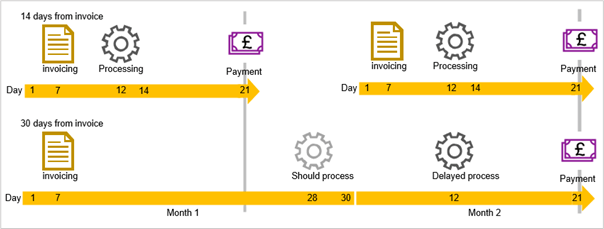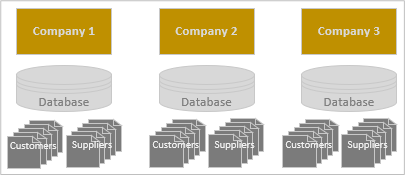Case Study - Wireless Logic
To the Rescue - Putting an Implementation Project back on Course

Metrics and measurements are estimates based on timings made during the time spent onsite. They are based on the average of time spent by users on the mentioned tasks and activities in this report. They should be considered as a guide only.
A project off-track
Wireless Logic Limited is Europe’s leading network provider for Mobile-to-Mobile and Internet-of-Things devices. The Finance Manager was a member of the selection committee that chose Sage X3 ERP as the solution to record trading transactions, track physical stock, structure business processes and report the monthly accounts for all companies within the group (both currently and added in the future). Being well-versed in the functions, processes, and requirements of both the legacy and this new accounting system, she took the responsibility of being the key-user contact for the implementation project of Sage X3.
Her impression of the solution and her confidence that it is very capable of meeting all the company’s accounting needs remains high, however the project to implement the system was floundering and the quality of delivery so far had not left a good impression. The existing vendor had sent at least four different consultants during the project and each time she needed to revisit the agreed system requirements with the individual arriving onsite, then double-check any configuration that they made. There seemed to be no hand-over from one consultant to the next.
The budget and deadline had seriously over-run and her overall impression of the project service delivery was not good.
She was simply asking for a consultant that “spoke her language” and could roll-out her ideas effectively. If something was genuinely not possible, then this person was expected to explain it concisely and propose a workable alternative.
So, the project management committee at Wireless Logic decided to enlist the help of REED HILL CONSULTANCY to give the implementation project that final push to get it over the line. The consultant sent to achieve this was András Radvánszky, an experienced and very capable Financials and Technical consultant who has hands-on experience with the Distribution Module and other bolt-on products.
Back on course
Of the nineteen measurable deliverables that András completed, three have been chosen for this case study.
Importing invoices from the external billing system
This billing system is a proprietary in-house solution that records actual time and data used by Wireless Logic customers per device. The data is extremely detailed which is essential to provide the monthly network usage invoices that are billed for each contract. The data volume in this system is too excessive to give analytical meaning for an accounting system so it needs to be aggregated to key measurement metrics and then imported into Sage X3. The accounting system would be the single source for the accounts department to collect and chase overdue customer payments.
The method to do this in the legacy system was to export the data to a comma-separated-value (CSV) file which would be aggregated manually in Excel before importing. This was very time-consuming and prone to human error.
It was decided that the new accounting system should remove the human element and simplify the process. So, an import template needed to be configured and a good, concise specification document written for the in-house software developer to write the data export routine from the billing system.
The import could be launched manually by the responsible Sage X3 user and once all billing system export anomalies were completely addressed, Sage X3 would be configured to run the import automatically. This improved import method resulted in a time-saving of about 4 days every month.
An opportunity to improve the cash collection procedure by approximately 7 days became apparent once the accuracy of the billing data import had been achieved. It was possible to re-utilize the payment proposal function to implement an efficient direct-debit process. This function was configured to identify customer invoices that should be settled by direct-debit and then to prepare a direct-debit bank file that would be uploaded to the company’s internet banking system securely and seamlessly. The legacy system [once again], required that this process be done manually with Excel. This was an area of concern with the company’s auditors.
Customer payments in the legacy system were often collected 7 days after the contractual due date, where most payment terms were 14 days from invoice. For some other payment terms of 30 days from invoice, the effective collection was 21 days late. This was because these invoices would miss the direct-debit collection run and therefore be postponed to the next run on the following month.
Now direct-debits are collected on or one day after the due-date.
Recognizing Cost of Sales when issuing Sales Invoices
Sage X3 will normally post the Cost of Sale value to the Profit/Loss statement when goods are shipped. Wireless Logic does not process invoices immediately after that because of extra rebate calculations, usage discounts and other customer incentives, so the effect was that the gross profit of the company was being understated. Fortunately the accounting system will allow changes to be made to the way journals will be posted in the General Ledger and therefore with a little know-how, the Stock Movement journal configuration was altered to retain the Cost of Sales (stock shipment value) in the Balance Sheet when goods are shipped. Another journal will be posted to transfer this movement value to the Profit/Loss report (into the Cost of Sales account) when an Invoice is issued to the customer. All movements will have precise comments so that individual transactions can be very clearly identified and the relationship between the shipment and the Invoice, clearly traced.
Customer and Supplier list filters in transaction screens
The legacy accounting system required a separate database for each company in the Wireless Logic Group, so customers or suppliers that traded with multiple Wireless Logic companies had to be duplicated in each respective database.
The Sage X3 software is designed to share customer and supplier (business partner) records with all company records in a single database so it would have been possible to merge the customer records that were the same trading entity.
However, this would have been a very arduous task because there were more than 20,000 active customer records (and several thousand suppliers) to process, find potential duplicates and then ensure that the outstanding balances were correct, all while holding up trading activity to be captured so-as not to confound the reconciliation of imported business partner balances with the legacy system. Therefore, the decision was made to import these trading entities unmerged in the new system.
This introduced a new problem… when a transaction was created for any business partner the complete record list would be available regardless of the Wireless Logic company, meaning that the transaction could potentially be booked to the incorrect business partner record.
András solved this problem by assigning a code that linked the business partner record to the correct company record and then applied a new filter to each transaction screen that would automatically reduce the list of business partners to only those applicable to the company. The risk of posting the transaction incorrectly was thereby mitigated and the business partner list has become far more manageable.
Over the finish-line
The new accounting system is now accepted well by the accounts department. They all appreciate the enhanced value that the Sage X3 ERP system brings over the legacy system.
- Significant gains have been made by the billing system integration and the direct-debit collection processes in the time it now takes to process the invoices, send them to their clients for scrutiny and collect the direct-debits on the due date, as opposed to a fixed payment processing run around the 21st of every month, which used to be a compromise made by the accounts team considering the delay in importing the billing information and actual payment processing.
Their cash-flow cycle has effectively improved by a mean average of about 10 days per month. - With the Cost of Sales journal now reflecting the Gross Profit more accurately, the Wireless Logic board and their investors are also confident that the profit presented in the accounts are more appropriate and consistent.
- End users are more content and confident with the adaption to the Customer search lists now that they are filtered by group company. Errors and delays have reduced sufficiently because the system ensures only relevant business partner records are displayed for a given group company transaction and they are not able to accidently enter an inappropriate business partner code.





